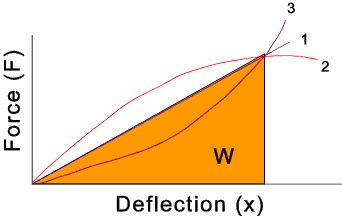Machine_Parts_Index
Spring Index
General Notes on Springs
More details on Spring design are to be found in the links below the table.
|
INTRODUCTION Springs are mechanical components designed to store mechanical energy, working on the principle of flexible deformation of material. Springs belong to the most loaded machine components. Applications for springs include:
Spring Rate
An important initial factor in spring design is the Spring Rate k = P / δ
P = Force (N) ka = T / θ T = Torque (Nm)θ = Angular displacement (Radians) Spring Class Metal springs are generally fall into one of three classes of duty;
Spring Energy Storage Based on the deformation pattern, springs can be divided into the following three types:
The W area under the spring characteristic curve represents the deformation work (energy) of a spring performed by the spring during its loading. Deformation energy of springs subjected to compression, tension or bending is specified by the formula:
For springs subjected to torsion the deformation energy is:
Spring State At any point in a springs operating life it can be in one of a number of states
A limiting load as defined by strength may be considered as at the limit of elasticity or at yield. |
Links to Spring Design
|
|
Machine_Parts_Index
Spring Index


